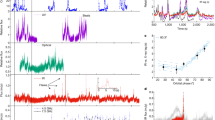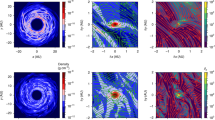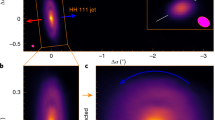Abstract
There is strong evidence that various types of exotic astronomical objects (quasars, active galactic nuclei, Cyg X-1, SS433) can be explained by accretion disks orbiting black holes. Most of the proposed models of such objects are plagued by instabilities. It is widely held, for example, that all accretion disks must be thermally and secularly unstable in their innermost parts, which seems to be in direct conflict with observations. Much effort has been made to find a stabilizing mechanism operating in the innermost parts of the disks. Here I show that such a mechanism does exist. It is of general relativistic origin, is purely mechanical—operating independently of viscosity and other micro-physical processes—and is similar to the mass loss caused by Roche lobe overflow in close binaries.
This is a preview of subscription content, access via your institution
Access options
Subscribe to this journal
Receive 51 print issues and online access
$199.00 per year
only $3.90 per issue
Buy this article
- Purchase on Springer Link
- Instant access to full article PDF
Prices may be subject to local taxes which are calculated during checkout
Similar content being viewed by others
References
Piran, T. Astrophys. J. 221, 652 (1978).
Abramowicz, M. A., Jaroszyński, M. & Sikora, M. Astr. Astrophys. 63, 221 (1978).
Abramowicz, M. A., Calvani, M. & Nobili, L. Astrophys. J. 242, 772 (1980).
Author information
Authors and Affiliations
Rights and permissions
About this article
Cite this article
Abramowicz, M. Innermost parts of accretion disks are thermally and secularly stable. Nature 294, 235–236 (1981). https://doi.org/10.1038/294235a0
Received:
Accepted:
Issue Date:
DOI: https://doi.org/10.1038/294235a0
This article is cited by
-
Resonant Oscillations of Accretion Flow and Khz QPOS
Astrophysics and Space Science (2005)
-
Spectral variability in hard X-rays and the evidence for a 13.5 years period in the bright quasar 3C273
Journal of Astrophysics and Astronomy (2002)
-
Accretion disc models around compact objects
Astrophysics and Space Science (1987)
-
Runaway instability in accretion disks orbiting black holes
Nature (1983)
-
Jets of moderate optical thickness from thick acceretion disks
Astrophysics and Space Science (1983)
Comments
By submitting a comment you agree to abide by our Terms and Community Guidelines. If you find something abusive or that does not comply with our terms or guidelines please flag it as inappropriate.



